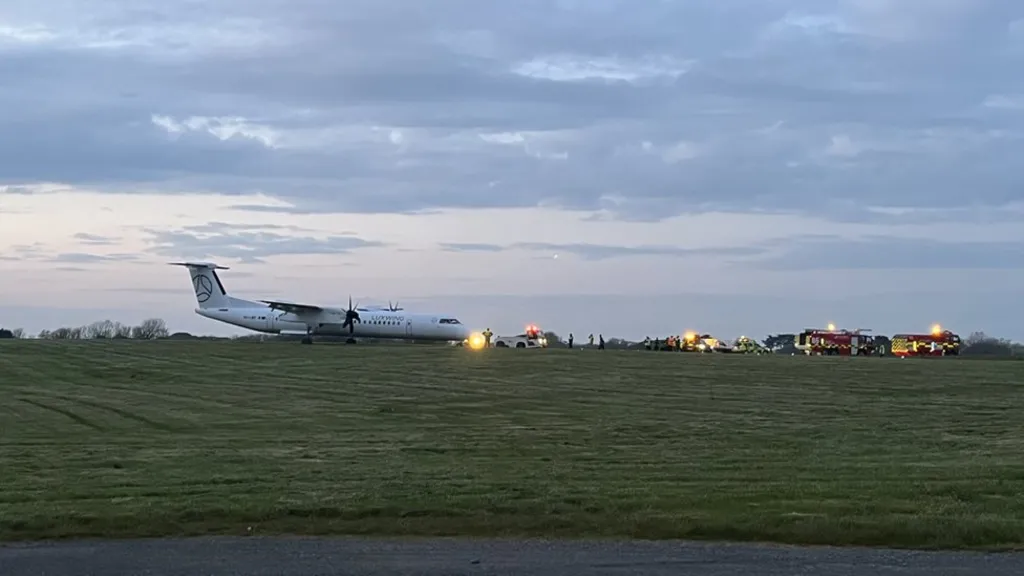ARFF Daily News
Published on:
Wednesday the 24th of April, 2024
Douglas DC-4 plane crashes in Alaska, officials say
By Faris Tanyos
A Douglas DC-4 airplane carrying two people was involved in a fiery crash Tuesday in the Alaska city of Fairbanks, just minutes after takeoff, authorities said.
The Federal Aviation Administration said in a statement that a Douglas C-54, which is a model of the Douglas DC-4, was carrying two people when it crashed southwest of Fairbanks International Airport at about 10 a.m. local time (2 p.m. ET).
The plane had taken off from Fairbanks International Airport at 9:55 a.m., Alaska State Troopers said in a news release. The plane crashed about seven miles south of the airport, where it "slid into a steep hill on the bank" of the Tatana River and caught fire.
No survivors have yet been found, state troopers said.
Multiple agencies responded and the public was asked to avoid the area.
The exact circumstances of the crash were not immediately known. The FAA and National Transportation Safety Board are investigating, the FAA said.
In a statement provided to CBS News, a spokesperson for Fairbanks International Airport acknowledged "the ongoing situation involving the Douglas DC-4 aircraft crash on the Tanana River near Kallenberg Road."
The spokesperson said the airport was "actively cooperating" with law enforcement.
The Douglas DC-4 was first manufactured in the late 1930s as a military aircraft, according to the Aviation Safety Network, and can carry several dozen passengers.
https://www.cbsnews.com/news/douglas-dc-4-plane-crash-fairbanks-alaska/

Emergency declared at Guernsey Airport as plane 'leaves the runway'
BBC
Guernsey Airport was closed for about two hours on Tuesday evening after an aircraft "left the runway", the site confirmed.
The Aurigny flight from Gatwick touched down at 18:43 BST and came to a stop within the runway's "end safety area" at the airport's western section.
There were no reported injuries among the 63 passengers and four crew on board.
A full emergency was declared but crews were stood down en route to the site.
No damage was reported to the aircraft, which was towed to the apron shortly after 20:30 BST.
All passengers safely disembarked from the aircraft and transferred to the airport terminal by bus, with the airport able to reopen at 20:55 BST.
https://www.bbc.com/news/world-europe-guernsey-68886071

NTSB Issues Final Report on 2022 Camarillo Mooney M20K Accident
Mooney M20K Fatal Accident; Pilot Loses Control in IMC
The NTB has concluded its investigation into an accident involving a Mooney M20K aircraft that resulted in the death of the pilot. The crash occurred on June 10, 2022, shortly after takeoff from an airport in Camarillo, California. The aircraft was destroyed upon impact after the pilot lost control during flight.
The NTSB's final report attributes the probable cause of the accident to the pilot's spatial disorientation and subsequent loss of control of the aircraft after entering IMC. These conditions were characterized by low visibility, mist, and cloud tops ranging from 400 to 1,600 feet.
On the day of the accident, the instrument-rated pilot, who was unfamiliar with the airport, planned a flight to his home base. Despite the challenging weather conditions, which were communicated during a pre-flight briefing, the pilot filed an IFR flight plan, requesting VFR-on-top. After a routine engine run-up and takeoff, the pilot likely entered the clouds but failed to establish contact with the departure controller as instructed.
Witness accounts and video evidence suggest that the aircraft was flying low and perpendicular to the takeoff direction without any signs of mechanical failure before it impacted the ground near a freeway. Investigations confirmed that the engine was functioning at high power at the time of the crash, and there were no pre-impact mechanical malfunctions or failures. The aircraft was also appropriately configured for the initial takeoff climb, dismissing the possibility of pilot error in aircraft configuration.
Further examination revealed the pilot was not instrument current; he had not met the recent flight experience requirements to operate under IFR. The pilot had significant cardiovascular health issues, including moderate coronary artery disease and an implanted pacemaker/defibrillator, which posed an increased risk of sudden impairment. However, no definitive forensic evidence suggested an incapacitating event occurred just before the crash.
The absence of ADS-B and radar tracking indicated that the aircraft did not reach a sufficient altitude after entering the clouds, supporting the theory of spatial disorientation. This condition can cause a pilot to lose sense of direction and aircraft attitude, leading to a loss of control.
The NTSB's investigation underscores the importance of adhering to flight and medical certification requirements, especially under challenging flight conditions. This accident illustrates the dangers of spatial disorientation and the need for rigorous compliance with aviation safety standards.
FMI: NTSB.gov

Today in History
30 Years ago today: On 24 April 1994 Douglas DC-3 VH-EDC ditched into Botany Bay after takeoff from Sydney, Australia; all on board survived.
Date: Sunday 24 April 1994
Time: 09:10
Type: Douglas C-47A-20-DK (DC-3)
Owner/operator: South Pacific Airmotive
Registration: VH-EDC
MSN: 12874
Year of manufacture: 1944
Total airframe hrs: 40195 hours
Engine model: Pratt & Whitney R-1830-92
Fatalities: Fatalities: 0 / Occupants: 25
Aircraft damage: Destroyed, written off
Category: Accident
Location: 0,1 km S off Sydney-Kingsford Smith International Airport, NSW (SYD) - Australia
Phase: Initial climb
Nature: Passenger - Non-Scheduled/charter/Air Taxi
Departure airport: Sydney-Kingsford Smith International Airport, NSW (SYD/YSSY)
Destination airport: Lord Howe Island Airport, NSW (LDH/YLHI)
Investigating agency: BASI
Confidence Rating: Accident investigation report completed and information captured
Narrative:
The DC-3 aircraft VH-EDC had been chartered to convey college students and their band equipment from Sydney (SYD) to Norfolk Island Airport (NLK) to participate in Anzac Day celebrations on the island. The aircraft was to proceed from Sydney (Kingsford-Smith) Airport to Norfolk Island, with an intermediate landing at Lord Howe Island Airport, NSW (LDH) to refuel. The flight was to be conducted in accordance with IFR procedures. The aircraft, which was carrying 21 passengers, was crewed by two pilots, a supernumerary pilot and a flight attendant. Preparations for departure were completed shortly before 09:00, and the aircraft was cleared to taxi for runway 16 via taxiway Bravo Three. The co-pilot was the handling pilot for the departure. The aircraft was cleared for takeoff at 09:07:53. All engine indications were normal during the takeoff roll and the aircraft was flown off the runway at 81 kts. During the initial climb, at approximately 200 ft, with flaps up and the landing gear retracting, the crew heard a series of popping sounds above the engine noise. Almost immediately, the aircraft began to yaw left and at 09:09:04 the pilot in command advised the Tower that the aircraft had a problem. The co-pilot determined that the left engine was malfunctioning. The aircraft speed at this time had increased to at least 100 kts. The pilot in command, having verified that the left engine was malfunctioning, closed the left throttle and initiated propeller feathering action. During this period, full power (48 inches Hg and 2,700 RPM) was maintained on the right engine. However, the airspeed began to decay. The co-pilot reported that he had attempted to maintain 81 KIAS but was unable to do so. The aircraft diverged to the left of the runway centreline. Almost full right aileron had been used to control the aircraft. The copilot reported that he had full right rudder or near full right rudder applied. When he first became aware of the engine malfunction, the pilot in command assessed that, although a landing back on the runway may have been possible, the aircraft was capable of climbing safely on one engine. However, when he determined that the aircraft was not climbing, and that the airspeed had reduced below 81 kts, the pilot in command took control, and at 09:09:38 advised the Tower that he was ditching the aircraft. He manoeuvred the aircraft as close as possible to the southern end of the partially constructed runway 16L. The aircraft was ditched approximately 46 seconds after the pilot in command first advised the Tower of the problem. The four crew and 21 passengers successfully evacuated the aircraft before it sank. They were taken on board pleasure craft and transferred to shore.
The investigation found that the circumstances of the accident were consistent with the left engine having suffered a substantial power loss when an inlet valve stuck in the open position. The inability of the handling pilot (co-pilot) to obtain optimum asymmetric performance from the aircraft was the culminating factor in a combination of local and organisational factors that led to this accident. Contributing factors included the overweight condition of the aircraft, an engine overhaul or maintenance error, non-adherence to operating procedures and lack of skill of the handling pilot. Organisational factors relating to the company included: 1) inadequate communications between South Pacific Airmotive Pty Ltd who owned and operated the DC-3 and were based at Camden, NSW and the AOC holder, Groupair, who were based at Moorabbin, Vic.; 2) inadequate maintenance management; 3) poor operational procedures; and 4) inadequate training. Organisational factors relating to the regulator included: 1) inadequate communications between Civil Aviation Authority offices, and between the Civil Aviation Authority and Groupair/South Pacific Airmotive; 2) poor operational and airworthiness control procedures; 3) inadequate control and monitoring of South Pacific Airmotive; 4) inadequate regulation; and 5) poor training of staff.

Mailing Address
Subscribe to our newsletter
Contact Us
We will get back to you as soon as possible.
Please try again later.
